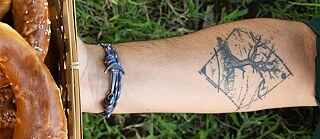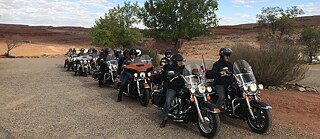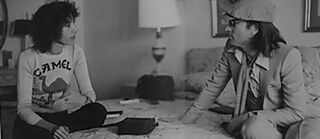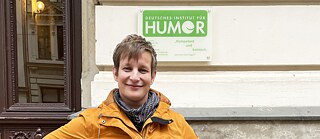Phänomen auf beiden Seiten des Atlantiks
Under the Skin — Tattoo Artists
Weil sie ihr Einkommen als Künstlerin aufbessern wollte, wurde Marten in den 1970er‑Jahren Tätowiererin in New York – als eine der ersten Frauen überhaupt. Damals war Tätowieren gesetzlich verboten, weshalb es noch mehr Spaß machte, sagt sie.
Diese Folge anhören: Apple Music | Spotify | Download
Diese Folge stammt von Anne-Rose Heck. Anne‑Rose ist freischaffende Journalistin für den öffentlich-rechtlichen Rundfunk in Deutschland. Sie war Austauschschülerin in Arkansas. In diesem Podcast unterhält sich Anne-Rose mit der Künstlerin Ruth Marten, die als Tätowiererin in New York arbeitet sowie mit Dirk McKay‑Horst und dem US‑Amerikaner Matt Roscoe vom Tattoo-Studio The Art of the Needle in Brühl. Die Musik zur Folge „Mika“, „Quartier“ und „Gelato“ stammt von Matthias Maschwitz. Außer dieser Episode hat Anne‑Rose Heck die Folge „Enjoy the Ride — About Bicycling“ produziert.
Transkript
Anne-Rose Heck: This is Anne-Rose Heck reporting from Brühl, Germany.
[ROCK MUSIC]
Anne-Rose Heck: Tattoos! It seems everyone has them. Some are hidden, but most of the tattoos nowadays are quite visible. Men and women alike have black, grey or very colorful designs spread on their arms, legs, or even the entire body. Eight million Germans already have tattoos and the trend seems to continue. I personally cannot imagine to have someone manipulate my skin and change it forever. But I am interested in tattoos from an artistic point of view. So I head to the nearby Max Ernst Museum in time for the opening of a big retrospective of Ruth Marten.
Woman: It is my great pleasure to welcome Ruth Marten from New York City at the Max Ernst Museum in Brühl. We are really happy that you are here with us!
Anne-Rose Heck: When I meet Ruth Marten in person I cannot imagine her as part of the tattoo scene in the Seventies. At least not immediately. I ask her to describe herself as an artist:
Ruth Marten: Well, I am very much about paper. I am very old fashioned. I love watercolor, I love line. I love tone. I love kind of an iconic composition. A lot of things are very centered. It comes from a sense of propriety, of being correct and then taking the correct and giving it a twist. That’s probably the strongest thread. But I love a beautiful hand. And because I love drawing so much — really, everything comes from drawing!
Anne-Rose Heck: But her passion for drawing wasn’t enough to earn a living. Ruth Marten explains how she started with tattooing:
Ruth Marten: Oh well, when I came out of school I suddenly realized that I had no commercial skills. Nobody was actually waiting to show my work in a gallery and I had to become part of the larger world — and fast. So I started doing book and magazine illustration which I got into right away and then I had also just gotten a tattoo — that was a form of drawing, so I thought maybe I can do that as well. At the time it was illegal in New York, which, of course, made it more fun and there was so much crime and craziness going on. They didn’t really care, they didn’t notice. So, I tattooed the punk music scene, I tattooed the gay men who were coming out. I tattooed women who wanted to change their identity because of self-liberation. It was fantastic to be able to spend time with people who looked upon these marks as being extremely special and a kind of a re-branding of who they were. So, I did that. I did a million things, ‘cause you have to do a million things to make a living. And I certainly did.
Anne-Rose Heck: Years later, already fairly well known, Ruth Marten even did a live tattoo performance.
Ruth Marten: Oh god, you dug up all this old stuff. Well, I did it once and I don’t even know how it looked at the end [LAUGHING]. Because I was in that show in Paris, I suddenly was exposed to all kinds of contemporary art. So I saw performance for the first time. So I thought I would try my hand at it. I am not very good at it, so I retired after my first performance. Good idea.
[ROCK MUSIC]
Anne-Rose Heck: Many years have passed since Ruth Marten has worked as a tattoo artist in New York. Now, tattooing isn’t forbidden anymore — on the contrary: it is a huge trend. Not only in the United States, also in Germany.
[STREET AND BICYCLE SOUND]
Anne-Rose Heck: I have never been to a tattoo studio before. But today I take my bike and ride to a little store downtown. Actually it looks very friendly with the green walls on the outside. And the name isn’t too spooky either. It is called The Art of the Needle. Inside I meet the two artists: The German Dirk McKay-Horst and the American Matt Roscoe. Both men have worked together in Grand Rapids, Michigan, before they moved to Germany. And I meet Matt’s wife Heather, who describes the place:
Heather Roscoe: Yeah, this tattoo studio is very clean and welcoming. It has a sense of home, like you can talk to the tattoo artists and feel like they are your best friends. In the back, they also have the nice tattoo chairs where it’s very comfortable and there are even curtains so there is privacy if there’s anything, you know, you need to get tattooed somewhere where you don’t want to be out in the open.
[SOUND OF TATTOOING]
Anne-Rose Heck: But a neat store alone isn’t enough. I ask Matt for the main ingredients of the business:
Matt Roscoe: Good artists, good atmosphere. Of course, gotta have some good music playing most of the time. I think it’s important to have artwork on the walls and things to inspire people and to encourage them to come in. For us what’s really important for our shop is that people can look inside the windows and see that we are not crazy mean criminals or something that people might expect from tattooers. We are friendly, we always have a pot of coffee on and offer coffee to the customers. So mostly I think it’s the atmosphere and giving people the feeling that it is a comfortable place to be even before they walk in the door.
Anne-Rose Heck: A comfortable place. As long as I don’t think about any needles that sounds quite convincing to me. And if the customer is well informed, he is able to find an artist that creates the right images for his or her body.
[SOUND OF TATTOOING]
Anne-Rose Heck: Dirk has worked as a tattooer for about 20 years and thinks that the whole industry has changed a lot.
Dirk McKay-Horst: Yes, absolutely. There is really artwork what comes to it. So most of the tattooers are artists as well, on canvas and oil or just create sculptures and something like that. And this influence into tattooing. So, you really have now variety from super realistic to all the simple things what was 20 years ago. So is the whole equipment what we have — new types of needless, new types of machines and all that. So it’s really just like art craft and it’s just evolving more and more.
Matt Roscoe: I think tattooing evolves so much just like everything else, like technology or whatever. 30, 40 years ago people listened to the radio, or A-tracks, or vinyl records, and then came CDs and mp3s and everything is digital now. It’s kind of the same thing with tattooing I think. Everything used to be simple — really, really simple — and then it kind of evolved. You know, the Ed Hardy stuff was cool in the early 2000s, but now it has evolved to more realistic things are cool today. So I am interested to see where it goes from here. But I think tattoos follow a natural progression just like everything else does.
Anne-Rose Heck: I am curious to find out about tattoo trends.
Matt Roscoe: In America we do a lot of names. Here in Germany, I’ve noticed a lot of people like to get their zodiac signs, Sternzeichen. I tattooed in America for three years and I can probably count on one hand the number of zodiacs signs I ever tattooed. I came to Germany and within the first month I think I must have done five or six of them at least. So for me as an outsider coming to Germany I think that’s the most popular thing in Germany. Specifically, that sets it apart from the United States as well.
Anne-Rose Heck: Zodiacs, infinity signs and everything else people find on pinterest or other social media platforms, which inspire them. That makes it a little difficult for the artist, who wants to draw the design himself.
Matt Roscoe: I think the optimal process is just to go back and forth a little bit, make sure you meet each other on the same page and you understand what the customer wants. The customer understands you as an artist and you kind of build something together. I think that means a lot more to the customer to get something unique — unique and that involves their input. And it’s also great for the tattooer then to be able to put their love and their passion into what they’re doing in some of their own artwork.
Anne-Rose Heck: Love and passion for drawing brings me back to Ruth Martin, the New York artist. What does she think of artwork that often covers huge parts of the body?
Ruth Marten: Oh yeah it’s funny, because I hear my mother’s voice inside my head say: ‘That’s too much. That’s too much.’ But of course, the quality of the work is extraordinary! And it’s very interesting: In the Nineties you started seeing these typographic tattoos and they are really extraordinary. But of course, that’s too much too. We are not exactly billboards to be read, while you’re walking down the stairs of the subway. But that’s what we do. You know, we walk through the streets in New York reading each other’s tattoos and t-shirts and such. People have to find a million and one ways to set themselves apart.
Anne-Rose Heck: Talking about Billboards: Matt’s right arm is totally dedicated to the Beatles. And Lady Gaga pays tribute to famous singer Edith Piaf with a massive rose tattooed down the back of her spine, anchored by the words La vie en Rose. Lady Gaga displayed this tattoo perfectly when winning [the Oscar].
[MUSIC]
Anne-Rose Heck: Still untattooed, this is Anne-Rose Heck reporting for THE BIG POND from Brühl, Germany.







